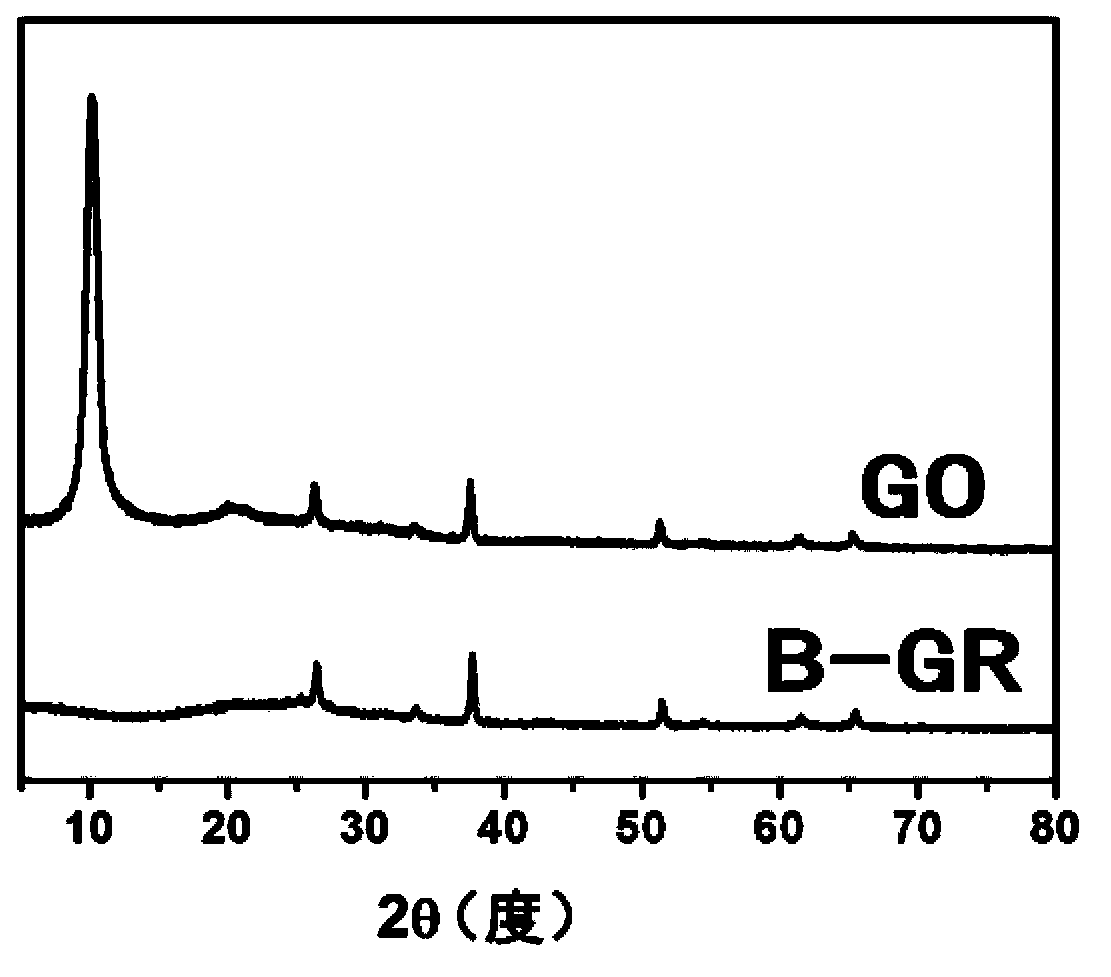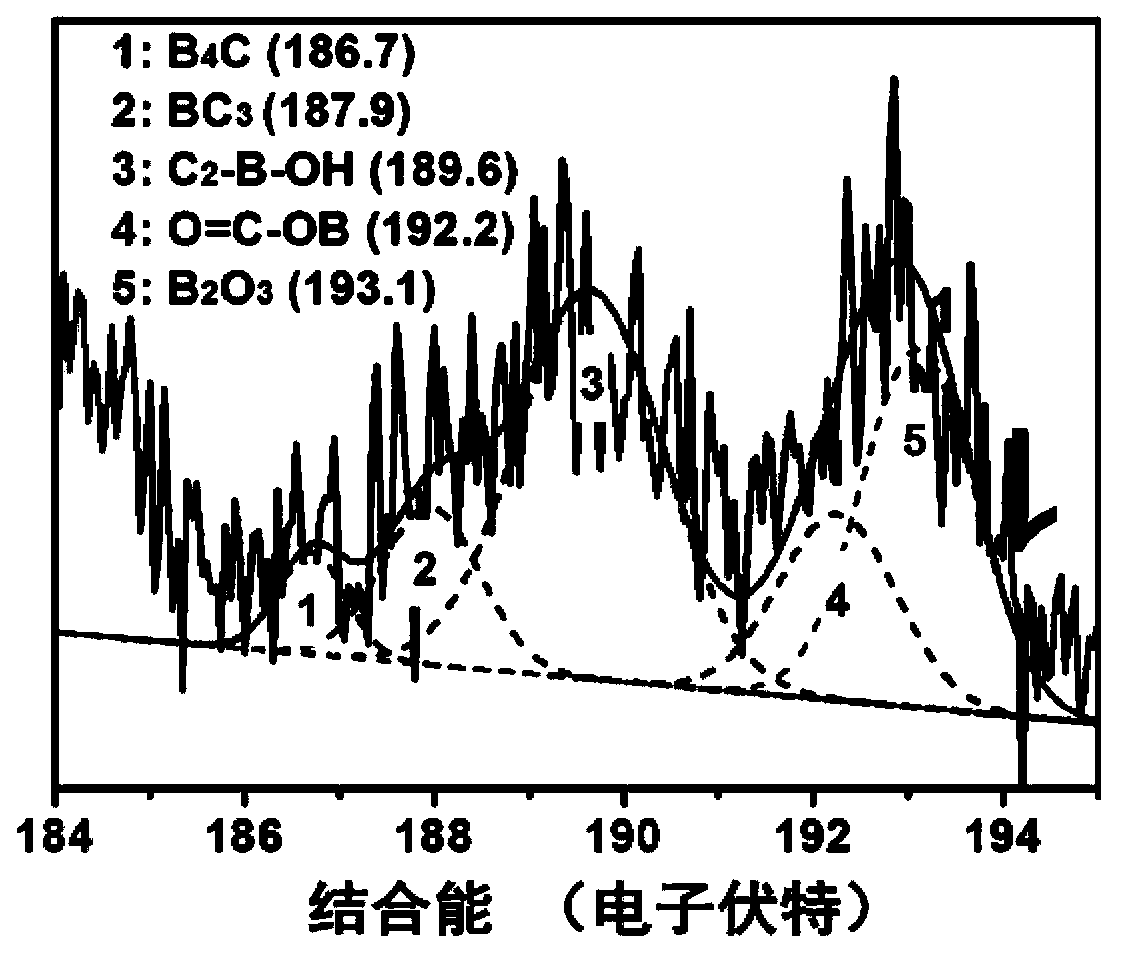A kind of preparation method of boron-doped graphene nanosheet composite tio2 photocatalyst
A technology of graphene nanosheets and photocatalysts, applied in chemical instruments and methods, physical/chemical process catalysts, chemical/physical processes, etc., can solve problems such as unfavorable industrial production, increased production costs, and poor thermal stability. Achieve the effects of promoting industrialization, promoting compounding, and simple equipment
- Summary
- Abstract
- Description
- Claims
- Application Information
AI Technical Summary
Problems solved by technology
Method used
Image
Examples
Embodiment 1
[0041] 1): Preparation of graphene oxide (GO)
[0042]The "Hummer" method was used to prepare GO, and the specific method was as follows: 3 g of graphite was dispersed in 12 ml of concentrated sulfuric acid containing 2.5 g of potassium persulfate and 2.5 g of phosphorus pentoxide, stirred at 80 °C for 4.5 h, then cooled to room temperature and placed at room temperature for 12 h . The resulting mixture was filtered, washed and naturally dried for 12 h. The pretreated graphite was added to 120ml of concentrated sulfuric acid, and 15g of potassium permanganate was added while stirring while keeping the temperature below 20°C, and stirred at 35°C for 2h. The mixture was diluted with 250 mL of deionized water, and the temperature was kept below 50°C in an ice-water bath. After stirring for 2 h, 0.7 L of deionized water was added, followed by the slow addition of 20 ml of 30% hydrogen peroxide. The mixed solution was bright yellow and bubbling. Stand still, remove the supernat...
Embodiment 2
[0053] A Boron-doped Graphene Nanosheet Composite TiO 2 A method for preparing a photocatalyst, which uses graphene oxide and gas-phase titanium dioxide (P25) as precursors, and uses a combination of low-temperature vacuum reduction and ultrasound to prepare boron-doped graphene nanosheet composite TiO 2 Photocatalyst, specifically comprises the following steps:
[0054] Preparation of Boron-doped Graphene Nanosheets
[0055] Adopt the Hummer method to prepare graphene oxide aqueous solution, measure the above-mentioned prepared graphene oxide aqueous solution with a concentration of 2 mg / ml, disperse it in ultrapure water, ultrasonically disperse for 1 hour, then add boric acid, the weight ratio of graphene oxide to boric acid 0.01:0.4, magnetically stirred for 1 hour and then evaporated to dryness at 60°C. The evaporated sample was then vacuum-reduced at 300°C for 3 hours, redispersed in ultrapure water, and then ultrasonicated for 10 hours, and 1M hydrochloric acid solutio...
Embodiment 3
[0059] A Boron-doped Graphene Nanosheet Composite TiO 2 A method for preparing a photocatalyst, which uses graphene oxide and gas-phase titanium dioxide (P25) as precursors, and uses a combination of low-temperature vacuum reduction and ultrasound to prepare boron-doped graphene nanosheet composite TiO 2 Photocatalyst, specifically comprises the following steps:
[0060] Preparation of Boron-doped Graphene Nanosheets
[0061] Adopt the Hummer method to prepare graphene oxide aqueous solution, measure the above-mentioned prepared graphene oxide aqueous solution with a concentration of 3 mg / ml, disperse it in ultrapure water, ultrasonically disperse for 1 hour, then add boric acid, the weight ratio of graphene oxide to boric acid 0.015:0.4, magnetically stirred for 1 hour and then evaporated to dryness at 60°C. The evaporated sample was then vacuum-reduced at 300°C for 3 hours, redispersed in ultrapure water, and then ultrasonicated for 10 hours, and 1M hydrochloric acid soluti...
PUM
| Property | Measurement | Unit |
|---|---|---|
| concentration | aaaaa | aaaaa |
| size | aaaaa | aaaaa |
Abstract
Description
Claims
Application Information
 Login to View More
Login to View More - R&D
- Intellectual Property
- Life Sciences
- Materials
- Tech Scout
- Unparalleled Data Quality
- Higher Quality Content
- 60% Fewer Hallucinations
Browse by: Latest US Patents, China's latest patents, Technical Efficacy Thesaurus, Application Domain, Technology Topic, Popular Technical Reports.
© 2025 PatSnap. All rights reserved.Legal|Privacy policy|Modern Slavery Act Transparency Statement|Sitemap|About US| Contact US: help@patsnap.com



